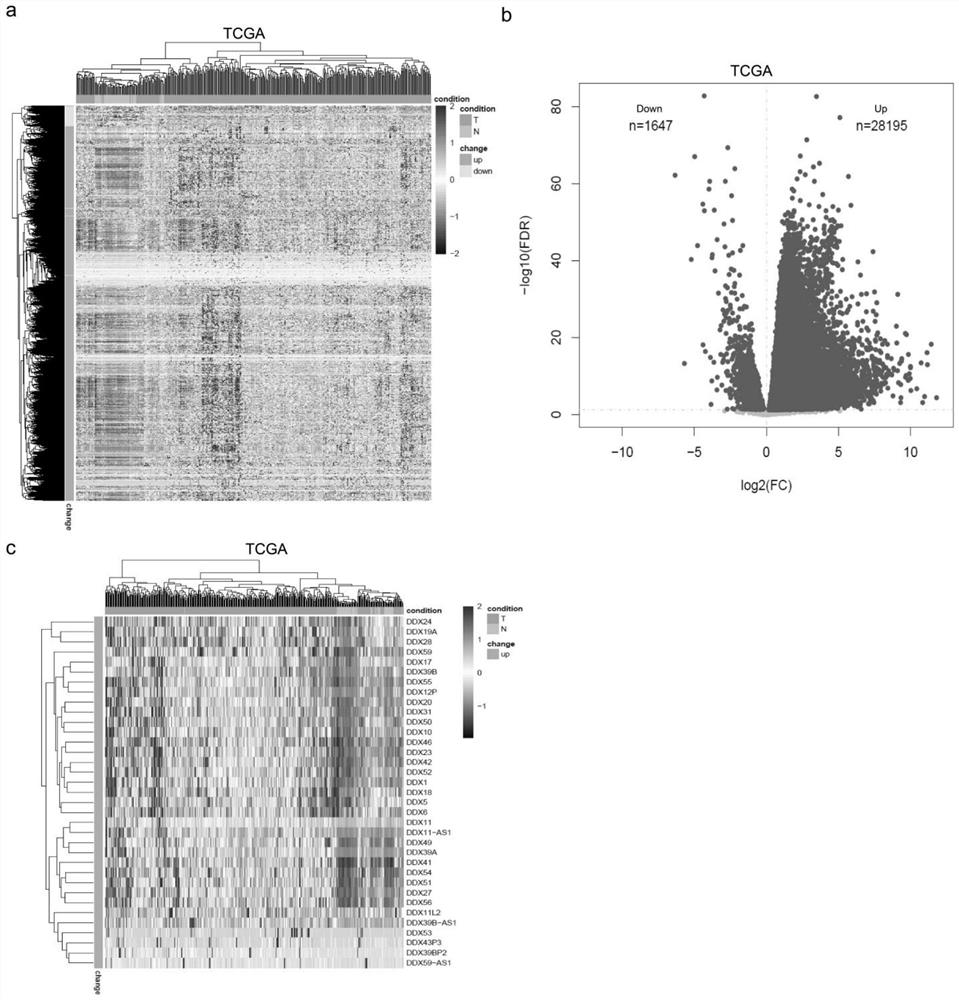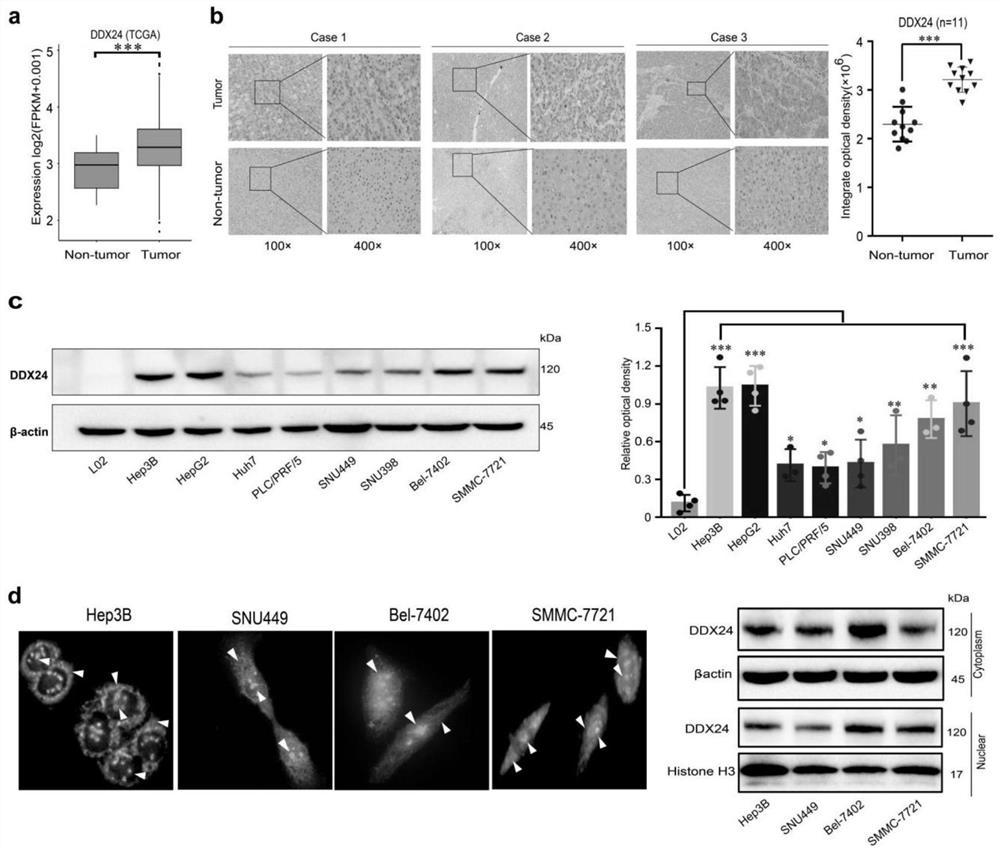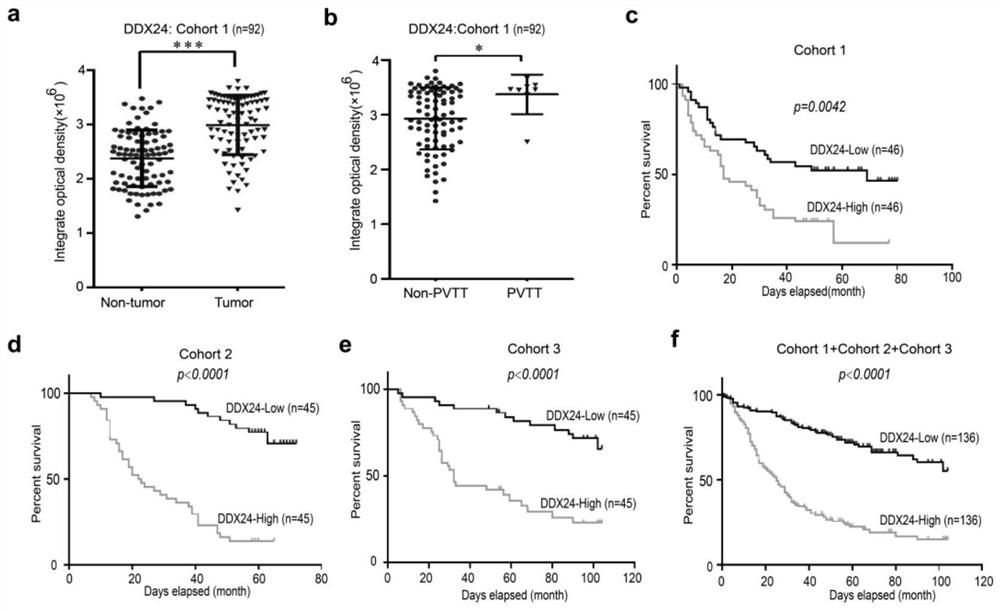Application of DDX24 and upstream and downstream molecules RFX8 and Lamb1 thereof in diagnosis and treatment of hepatocellular carcinoma
A DDX24, 1.DDX24 technology, applied in the field of diagnosis and treatment of hepatocellular carcinoma, can solve the problems of lack of disease research and treatment methods, and unclear precise mechanism of action
- Summary
- Abstract
- Description
- Claims
- Application Information
AI Technical Summary
Problems solved by technology
Method used
Image
Examples
Embodiment 1
[0068] Example 1 Correlation between the expression of DDX24 in hepatocellular carcinoma tissue and the progression of HCC
[0069] 1. Experimental process
[0070] 1.1. Immunohistochemical (IHC) staining
[0071] Liver cancer tissue samples were collected from the Fifth Affiliated Hospital of Sun Yat-sen University. Tissues were fixed overnight in 10% neutral formalin, dehydrated using an increasing concentration gradient, and embedded in low melting point paraffin. Serial 4 micron thick tissue sections were cut and mounted on siliconized glass slides. Immunohistochemical staining used a streptavidin-peroxidase conjugated method. Each tissue section was deparaffinized, rehydrated, immersed in antigen retrieval solution, boiled at 100°C for 10 min, and incubated with peroxidase inhibitors. After blocking non-specific binding with normal goat serum, tissue sections were incubated overnight at 4°C with the following primary antibodies: anti-DDX24 and anti-HPA002554 (Sigma, U...
Embodiment 2
[0099] Example 2 DDX24 regulates the EMT signaling pathway of HCC migration and invasion
[0100] 1. Experimental process
[0101] 1.1. Construction of lentivirus and cell infection
[0102] Cells were infected with a lentiviral vector (U6-sh-DDX24-EGFP-IRES-puromycin) purchased from GeneCopoeia (Rockville, Maryland, USA) to establish DDX24 knockdown or stable overexpression cell lines. HCC cells were infected with recombinant lentiviral transduction units by 0.8 μg / ml polyethylene, and stable cells were selected by 1 ug / ml puromycin two weeks later, and the efficiency of RNA interference was evaluated by qRT-PCR and Western blotting.
[0103] 1.2. RNA sequencing (RNA-seq)
[0104] Total cellular RNA was purified using TRIzol reagent (Invitrogen, Carlsbad, CA). Each set of samples was then used to construct RNA-seq strand-specific libraries and sequenced using the NuGEN Ovation RNA-Seq system. The counts per gene were normalized into FPKM (fragments per kilobase per millio...
Embodiment 3
[0116] Example 3 DDX24 regulates the ERK / AKT signaling pathway of cell proliferation and tumor growth
[0117] 1. Experimental process: with embodiment 1 or embodiment 2.
[0118] 2. Experimental results
[0119] Through CCK-8 and clone formation experiments, it was found that reducing the expression of DDX24 could inhibit the proliferation of liver cancer cells in vitro ( Figure 6 a) and clone formation ( Figure 6 b). We also observed in a xenograft mouse model that DDX24 deficiency significantly suppressed subcutaneous tumor size compared to controls ( Figure 6 c-6e) and weight ( Figure 6 f). In addition, the phosphorylation levels of cell proliferation pathway factors AKT and ERK were also significantly down-regulated in knockdown DDX24 cells ( Figure 6 g). These results suggest that DDX24 regulates HCC proliferation and tumor growth through the ERK / AKT signaling pathway.
PUM
 Login to View More
Login to View More Abstract
Description
Claims
Application Information
 Login to View More
Login to View More - R&D
- Intellectual Property
- Life Sciences
- Materials
- Tech Scout
- Unparalleled Data Quality
- Higher Quality Content
- 60% Fewer Hallucinations
Browse by: Latest US Patents, China's latest patents, Technical Efficacy Thesaurus, Application Domain, Technology Topic, Popular Technical Reports.
© 2025 PatSnap. All rights reserved.Legal|Privacy policy|Modern Slavery Act Transparency Statement|Sitemap|About US| Contact US: help@patsnap.com



